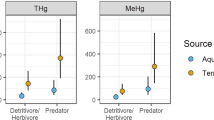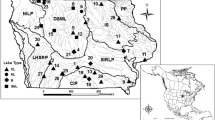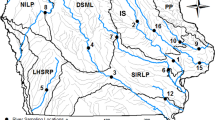Abstract
Sunfish and a minnow species were used as indicators of anthropogenic mercury contamination in an east Tennessee stream system receiving multiple point and non-point discharges. The monitoring of bluegill (Lepomis macrochirus) and redbreast sunfish (Lepomis auritus) identified bioavailable mercury near three geographically separate industrial facilities, and was able to detect decreases in contamination with distance away from these facilities. In general, total mercury concentrations in the tissue of sunfish in this study were low in comparison to the most commonly cited human health threshold limits, although concentrations at some sites exceeded 1 μg/g. Caged blacknose dace (Rhinichthys atratulus) were monitored in conjunction with resident fish as an indicator of more discrete sources in selected headwater streams where fish movement was deemed a potential factor affecting mercury body burdens. Mercury concentrations in muscle tissue of caged dace after 12 weeks exposure were generally low (<0.2 μg/g) at all sites but higher than in fish from reference streams. mercury accumulation varied between species (sunfish vs. dace) and monitoring method (caged vs. resident) at the same site, with sunfish tending to accumulate higher concentrations of mercury than resident dace which, in turn, contained about twofold higher concentrations than caged dace. However, the site-to-site pattern of mercury accumulation was similar. This study demonstrates the utility of using small stream dwelling fish with restricted home ranges as a tool for identifying and evaluating the bioavailability of mercury sources in large industrial or urbanized settings.
Similar content being viewed by others
References
Bloom, N. S.: 1992, ‘On the Chemical Form of Mercury in Edible Fish and Marine Invertebrate Tissue’, Can. J. Fish. Aquat. Sci. 49, 1010–1017.
Cope, G. W., Wiener, J. G. and Rada, R. G.: 1990, ‘Mercury Accumulation in Yellow Perch in Wisconsin Seepage Lakes: Relation to Lake Characteristics’, Environ. Toxicol. Chem. 9, 931–940.
Clarkson, T. W.: 1990, ‘Human Health Risks From Methylmercury in Fish’, Environ. Toxicol. Chem. 9, 957–961.
Crawford, K. J., and Luoma, S. N.: 1993, ‘Guidelines for Studies of Contaminants in Biological Tissues for the National Water-Quality Assessment Program’, U.S. Geological Survey, 69 pp.
EPA (U.S. Environmental Protection Agency): 1991, Methods for the Determination of Metals in Environmental Samples, EPA-600/4-91-010, Environmental Monitoring Systems Laboratory, U.S. Environmental Protection Agency, Cincinnati, Ohio.
EPA (U.S. Environmental Protection Agency): 1993, Guidance for Assessing Contaminant Data for Use in Fish Advisories, Vol. 1, Fish Sampling and Analysis, U.S. Environmental Protection Agency, Washington, D.C.
EPA (U.S. Environmental Protection Agency): 1994, Guidance for Assessing Contaminant Data for Use in Fish Advisories, Vol. 2, Risk Assessment and Fish Consumption Limits, U.S. Environmental Protection Agency, Washington, D.C.
Elwood, J. W., Turner, R. R., Cook, R. B., and Bogle, M. A.: 1987, ‘Behavior and Fish Uptake of Mercury in a Contaminated Stream’, Proceedings, 6th International Conference on Heavy Metals in the Environment, New Orleans, La., Sept. 15–18, 1987, CEP Consultants, Ltd. Edinburgh, U.K.
Etnier, D. A. and Starnes, W. C.: 1993, The Fishes of Tennessee, The University of Tennessee Press, Knoxville, Tennessee, 681 pp.
FDA (Food and Drug Administration): 1984, ‘Action Level for Methylmercury in Fish’, Federal Register 49(224), 45663.
Gatz, A. J.Jr. and Adams, S. M.: 1994, ‘Patterns of Movement of Centrarchids in Two Warmwater Streams in Eastern Tennessee’, Ecology of Freshwater Fish 3, 35–48.
Heit, M., Schofield, C., Driscvoll, C., and Hodgkiss, S.: 1989, ‘Trace Element Concentrations in Fish from Three Adirondack Lakes with Different pH Values’, Water, Air, and Soil Pollut. 44, 9–30.
Huckabee, J. W., Elwood, J. W. and Hildebrand, S. G.: 1979, ‘Accumulation of Mercury in Freshwater Biota’, In: Nriagu (ed.), The Biogeochemistry of Mercury in the Environment, Elsevier/North-Holland Biomedical Press.
IRIS (Integrated Risk Information System).: 1995, U.S. Environmental Protection Agency, Duluth, MN.
Kornegay, F. C., West, D. C., Evans, R. A., Tardiff, M. F., Adams, F. D., and Mucke, P. C.: 1992, Oak Ridge Reservation Environmental Report for 1991, ES/ESH-22/VI & 2. Martin Marietta Energy Systems, Inc., Oak Ridge, Tennessee.
Kornegay, G. C., West, D. C., McMahon, L. W., Murphy, J. B., Shipe, L. G., Koncinski, W. S.: 1993, Oak Ridge Reservation Environmental Report for 1992, ES/ESG-31/VI & 2. Martin Marietta Energy Systems, Inc., Oak Ridge, Tennessee.
Lange, T. R., Royals, H. E., Connor, L. L.: 1993, ‘Influence of Water Chemistry on Mercury Concentration in Largemouth Bass from Florida Lakes’, Transactions of the American Fisheries Society 122, 74–84.
Marsh, D. O., Clarkson, T. W., Cox, C., Meyers, G. J., Amin-Zaki, L., and Al-Tikriti, S.: 1987, ‘Fetal Methylmercury Poisoning: Relationship Between Concentration in Single Strands of Material Hair and Child Effects’, Archives of Neurology 44, 1017–1022.
Minnesota Department of Health: 1994, ‘Minnesota Fish Consumption Advisory’, Minneapolis, Minnesota.
Munro, D. J., and Gummer, W. D.. 1980, ‘Mercury Accumulation in Biota of Thunder Creek, Saskatchewan’, Bull. Environm. Contam. Toxicol. 25, 884–890.
Parks, J. W., Curry, C., Romani, D. and Russel, D. D.: 1991, ‘Young Northern Pike, Yellow Perch, and Crayfish as Bioindicators in a Mercury Contaminated Watercourse’, Environ. Monit. Asses. 16, 39–73.
Peterson, M. J. and Southworth, G. R.: 1993, ‘Bioaccumulation Studies’, in: Ashwood, T. L. (ed.), Seventh Annual Report on the ORNL Biological Monitoring and Abatement Program. Draft ORNL/TM-12385. Oak Ridge National Laboratory, Oak Ridge, Tennessee.
Peterson, M. J. and Southworth, G. R.: 1994, ‘Bioaccumulation Studies’, in: Loar, J. M. (ed.), Third Report on the Oak Ridge National Laboratory Biological Monitoring and Abatement Program for White Oak Creek Watershed and the Clinch River, ORNL/TM-11358. Oak Ridge National Laboratory, Oak Ridge, Tennessee.
Phillips, G. R., Medvick, P. A., Skaar, D. R., and Knight, D. E.: 1987, Factors Affecting the Mobilization, Transport, and Bioavailability of Mercury in Reservoirs of the Upper Missouri River Basin. Fish and Wildlife Report 10, United States Department of the Interior Fish and Wildlife Service, Washington, D.C.
PTI: 1994, ‘Mercury: The Case for Site-specific Aquatic Criteria’, PTI News, pp. 1–7.
Rada, R. G. and Findley, J. E.: 1986, ‘Environmental Fate of Mercury Discharged into the Upper Wisconsin River’, Water, Air, and Soil Pollution 29, 57–76.
Rogers, D. W., and Quadri, S. U.: 1982, ‘Growth and Mercury Accumulation in Yearling Yellow Perch, Perca flavescens, in the Ottowa River, Ontario’, Env. Biol. Fish. 7(4), 377–383.
Skerfving, S.: 1988, ‘Mercury in Women Exposed to Methylmercury Through Fish Consumption, and in Their Newborn Babies and Breast Milk’, Bull. Environ. Contam. Toxicol. 41, 475–482.
Sokal, R. R. and Rohlf, F. J.: 1981, Biometry, W. H. Freeman and Company, San Francisco, CA.
Southworth, G. R.: 1990, ‘PCB Concentrations in Stream Sunfish (Lepomis auritus and L. macrochirus) in Relation to Proximity to Chronic Point Sources’, Water, Air, and Soil Pollut. 51, 287–296.
Southworth, G. R., Peterson, M. J., Adams, S. M. and Blaylock, B. G.: 1994a, ‘Estimation of Appropriate Background Concentrations for Assessing Mercury Contamination in Fish’, Bull. Environ. Contam. Toxicol. 53, 211–218.
Southworth, G. R., Turner, R. R. and Nourse, B. D.: 1994b, Site Specific Water Quality Criterion for Total Mercury in East Fork Poplar Creek Downstream of the Y-12 Plant, Y/ER-126. Y-12 Plant, Oak Ridge, Tennessee.
Southworth, G. R., Turner, R. R., Peterson, M. J. and Bogle, M. A.: 1995, ‘Form of Mercury in Stream Fish Exposed to High concentrations of Dissolved Inorganic mercury’, Chemosphere 30(4), 779–787.
Southworth, G. R., and Peterson, M. J.: ‘Bioaccumulation Studies’, in: Hinzman, R. L. (ed.), Third Report on the Oak Ridge Y-12 Plant Biological Monitoring and Abatement Program for East Fork Poplar Creek, Draft Y/TS-889, Y-12 Plant, Oak Ridge, Tennessee (in press).
Suchanek, T. H., Richerson, P. J., Woodward, L. A., Slotton, D. G., Holts, L. J., and Woodmansee, C. E. E.: 1993, ‘Survey and Evaluation of Mercury’, in: Sediment, Water, Plankton, Periphyton, Benthic Invertebrates and Fishes Within the Aquatic Ecosystem of Clear Lake, California, A Report Prepared for the Environmental Protection Agency Region 9: Superfund Program. Institute of Ecology, Division of Environmental Studies, University of California Davis.
TVA (Tennessee Valley Authority): 1985, Instream Contaminant Study, Task 4: Fish Sampling and Analysis, Report to the U.S. Department of Energy, Oak Ridge Operations Office. Tennessee Valley Authority, Office of Natural Recources and Economic Development, Knoxville, Tennessee.
Uthe, J. F., Atton, F. M. and Royer, L. M.: 1973, ‘Uptake of Mercury by Caged Rainbow Trout (Salmo gairdneri) in the South Saskatchewan River’, J. Fish. Res. Board Can. 30, 643–650.
VanWinkle, W., Counts, R. W., Dorsey, J. G., Elwood, J. W., Lowe, V. W., McElhaney, R., Schlotzhauer, S. D., Taylor, F. G. and Turner, R. R.: 1984, Mercury Contamination in East Fork Poplar Creek and Bear Creek, ORNL/TM-8894, Oak Ridge National Laboratory, Oak Ridge, Tennessee.
WHO (World Health Organization): 1990, Environmental Health Criteria 101: Methylmercury, Geneva, Switzerland.
Wiener, J. G.: 1983, ‘Comparative Analysis of Fish Populations in Naturally Acidic and Circummeutral Lakes in Northern Wisconsin’, U.S. Fish and Wildlife Service Report, FWS/OBS-80/40.16. 107 pp.
Zar, J. H.: 1984, Biostatistical Analysis, Prentice-Hall, Inc., Englewood Cliffs, New Jersey.
Author information
Authors and Affiliations
Rights and permissions
About this article
Cite this article
Peterson, M.J., Southworth, G.R. & Crumby, W.D. Monitoring mercury in fish in a stream system receiving multiple industrial inputs. Environ Monit Assess 40, 91–105 (1996). https://doi.org/10.1007/BF00395169
Received:
Revised:
Issue Date:
DOI: https://doi.org/10.1007/BF00395169




